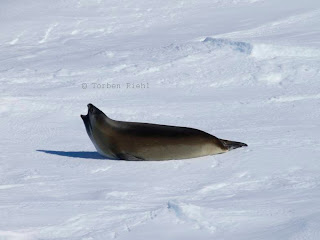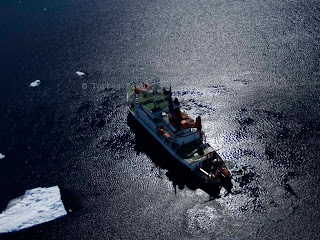

Happy new year to all of you! As I did not write anything since before Christmas, I will try to recall the most important things for me that happened on board RV "Polarstern" during the last week or so. Christmas Eve was a great day for me. I had the chance to assist the Dutch group of Top-Predator researchers with their helicopter counting. We started in the morning and the flight, which consisted of two transects, took about two hours. At this time huge and fast ice flows covered the sea, and a network of open water in between caused a lot of zigzagging for "Polarstern". But it is a very strong icebreaker and no ice flow was thick enough to withstand it. There was no more ramming at this time. This was not true for the RV "S.A. Agulhas", the South African research and supply vessel. During our flight we met them and they were stuck in the ice. We came quite close to the ship and waved to the people on board. We greeted them and flew on. They were also heading for "Neumayer II" where the unloading and logistics for the supply of the South African Station "Sanae IV" will be accomplished.
Just about 30 minutes later I became a very happy person, if I wasn't already because of the flight: we spotted the rarest seal species in Antarctic waters, the "Ross Seal"!!! We came very close and I could take some very nice pictures. Jan - head of the top-predator team- said, I was
a "very lucky bastard" as people like him spend many hours of counting and never see such a seal. One of the pictures shows this seal. At the end of the second transect "Polarstern" was deploying a net and because of the crane in the air, the helicopter was not allowed to land. The pilot used the time to fly around some Icebergs and to slowly fly around "Polarstern". As it took some more time, we landed on an ice flow close to the ship. On one of the pictures you can see "Polarstern" from above and the ice flow we landed on. What an adventure!
December 24th and the two following days of Christmas were celebrated in a very nice way, probably the nicest way possible, when you are separated from your families and beloved. On Monday at 4pm the crew stopped working and everything was prepared for Christmas celebration. There was a German standard Christmas dinner (potato salad and sausages) and afterwards an official celebration in the blue saloon, the library and reception room of the ship. Both, Captain and chief scientists spoke to all the crew and scientists, encouraged everybody and reminded of poor people living on earth under harsh conditions. A choir sang Christmas songs and the Christmas story was read. This celebration was very unusual for me. I felt impressed and for the first time I really missed being at home. Afterwards, we celebrated on through the night with self made theatre, singing, and music and dancing. On first day of Christmas, December 25th, work started early. Not only cleaning up but also science started again. No ship time was wasted and the sense of Christmas only remained in the special meals we had during
this day and the next. Goose, lobster and buffet are examples for the perfectly cooked and served lunches and dinners we had only for this days, even served with red and white wines or beer. The amount of data for my diploma thesis has immensely increased. After difficulties with the extraction of DNA at the beginning, we have now finished sorting the material from the first and second station and already got more than 100 successful extractions. I spend most time of the days since Christmas in the Lab, doing extractions, and I also had to prepare another talk. I hardly had the chance to go outside and have a look at the ocean. Even though, I finally managed to see my first "Minke Whales" on second day of Christmas. And just some minutes after the first whale there were three more! Again lucky! It was wonderful to see these them swimming gracefully through the ice covered ocean surfacing every now and then.
In the daily seminar almost every group has presented their topics and scientific interests. Therefore, now different topics, even non-marine talks can be presented. And finally, about nine months after my expedition to Borneo I managed to prepare a talk. I really enjoyed remembering all those impressions and adventures. I gave this talk on Saturday, 29th of
December, at the very beginning of the third big station.
During this last week we headed northward on 3°W. Every day the nights got darker (today we have about four dark hours per night), the ice cover declined to small thawed ice flows and even oceanic waves were back about December 29th. New Year 's Eve was approaching and we were at station. Since almost two days "Polarstern" stayed at special coordinates and about 50 scientists did not get much sleep. It was a deep-sea station we were at. Underneath the ship's hull more than 5000m of water separated us from the sea floor. For gear that had to work down there, like our "Epibenthic Sledge" (EBS), it took about eight hours, from the time of deployment until it was back on board. During the night to Monday 31st, we deployed a bottom-trawl and
the EBS. Both were completely filled with fine soft sediment: mud as non-scientists would call it. To find the animals in there, we had to sieve it all. It was, both gears together, at least two tonnes of sediment to sieve and it took many hours. It was fun and we felt like children
playing in the mud, but it was exhausting and cold. I sent a picture, shot by Brigitte Ebbe that shows us working with the mud from the trawl. I went to bed for three hours after breakfast of December 31st, but before that, I enjoyed revitalising my fingers and feet in the ship's sauna. I love this ship! Today I have pain in my hands from the million fold repetition of shaking the sieves against the floor and carrying the heavy buckets.
Hopefully we'll find a lot of animals in there! While the gear for catching animals is robust, other gear like the deep-sea camera and sensitive sensors did not make it. Yes, some scientists have lost the fight against more than 500bar pressure. Everybody tries to do his best, to repair instruments and get as much data as possible. We are lucky to be on "Polarstern", as we all can completely count on the crew and their professions. They are the best!In time for the celebration of New Year's Eve, work finished 4pm and we sailed to our next position at 3°E. Again we had lots of funny activities,
arranged mostly by the scientists. Especially the first "OlympiPolarstern Games" raised the mood. 34 crew members and scientists were assembled to 17 teams and competed in five funny disciplines. The crowd applauded laughing. After an official celebration of the beginning of 2008
on the bridge, we had a birthday party as one scientist and one helicopter pilot had birthday on January 1st. The view on the ocean and icebergs as well as the blowing horn of "Polarstern" made up for the missing fireworks, which is forbidden southern to 60°S for environmental reasons. During the rest of the night we danced 2007 away and welcomed 2008.



